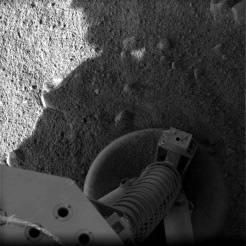
One of the major challenges with the Kill-A-Watt is it requires that the device to be measured must be unplugged and then plugged into the Kill-A-Watt’s front receptacle to measure energy consumption. This precludes measuring consumption of direct-wired devices such as lighting and dishwashers, along with 220V appliances such as electric dryers.
Measuring the consumption of the entire household can also provide interesting and useful data – for example, what is the ‘always-on’ consumption?
The easiest way to measure the consumption for the household is to do it at the meter. Unfortunately, most meters do not provide that data to the consumer directly; some newer meters being deployed as part of utility Smart Grid initiatives support ZigBee, but those are not widely deployed.
Several years ago a company called Blue Line Innovations created and patented (US 7174260) a device to accomplish this. Consisting of two parts – a transmitter which attaches to the household meter and a remote display – it can monitor the near real-time usage through the meter.
It does this via one of two mechanisms within the meter-mounted portion of the device: for old mechanical dial meters there is an infrared transmitter and receiver which monitors the rotation of the dial. Newer meters have an IR transmitter on the front or top of the meter itself which periodically pulse to indicate usage; the infrared receiver of the monitor can be located to pick up that pulse. In either case, the unit is mounted to the meter via a standard hose clamp and sends the consumption rate to the remote display. Approximately every 30 seconds the display updates with the current energy usage along with calculated cost information based on the rate the user programs into the display. Month to-date and estimated monthly consumption is also provided.
Black & Decker resells this device under their label as the EM100B Power Monitor.
On the positive side, this device is relatively easy to install (with some caveats), provides a near real-time view of total energy consumption, and has decent range. A very useful feature is a ‘tare’ display, which essentially zeroes out the current consumption so that the user can turn on an appliance – say, a microwave oven – and see the delta energy use and cost that the appliance requires. This is also useful for lighting – comparing incandescent bulbs to fluorescent in the same fixture, for example.
There are some challenges with the device, however – the first unit I had died within two weeks. The second one failed within a year, although B&D refunded the cost of the unit. Lining up the infrared receiver to pick up the pulses is relatively straightforward, but I had difficulty receiving data if the sun was shining directly on the meter. Batteries in the transmitter must be periodically replaced, and given exposure to outdoor temperature extremes lithium AA batteries are recommended.
Additionally, there is no supplied mechanism for storing and collecting the data, although recently Microsoft and Blue Line have announced a WiFi option ($150!) to permit data to be collected by Microsoft’s ‘Hohm’ . This lack does make tracking consumption changes over time difficult at best.
The EM100B is a good option for someone who wants a relatively simple whole-house monitor – but there are better solutions if more detailed information is desired, including the subject of the next post, the Energy, Inc. TED 5000.
 For a while I’ve been interested in figuring out why I send so much money to NStar every month. That interest has spawned some product ideas, a business plan or two, and a few purchases.
For a while I’ve been interested in figuring out why I send so much money to NStar every month. That interest has spawned some product ideas, a business plan or two, and a few purchases.

